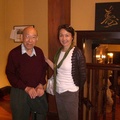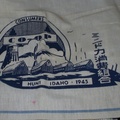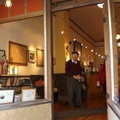Read Part 5 >>
The government began sending a notice to each family informing them to report with their belongings on a designated day at a specific location. Mr. Hori recalls waiting in line on 8th Avenue and Lane St. and boarded the bus with his family to Puyallup.
Puyallup is a city, south of Seattle, about five miles east of Tacoma. The Puyallup fairground is the site for the Puyallup Fair that began in the 1900’s that included special attractions, rides, and festivities. Even today, the Puyallup Fair is a popular family attraction for two weeks in the fall. Many of the Japanese had enjoyed the annual fair but never did they imagine that in May 1943, the Fairgrounds would become the temporary Japanese American internment camp for those living in the Seattle vicinity. How ironic that such a happy place would become one of such sadness and misunderstanding.
According to Mr. Hori, the fairground was divided into four areas, A, B, C, and D; each enclosed by barbed wire and manned by armed guards. Though the guards were friendly, those interned were not allowed to move freely between the areas, and doing so required special permission.
Each Japanese family was assigned to a specific barrack based on their home address. In this way, the government tried to keep families and neighbors together. The Hori family was placed in barrack A, which were newly built barracks on the fairground parking lot. Others weren’t as fortunate, as some were assigned to Area D, where their living quarters were converted horse stalls.
In the barracks at Puyallup, the rooms for the families were all the same size. It didn’t matter whether you had a family of six or were just a young couple, as that’s all that was available. Each room consisted of cots and a pot bellied wood stove in the center. This provided enough heat as they were there during the warmer months of the year. Mr. Hori said his family was considered lucky because they were given cotton mattresses. Apparently, these soon ran out so many others had to do with mattresses filled will straw. The washrooms and toilets were located down the hall from the rooms. As one can imagine, they were very simple structures. The toilets were just a board with a hole, flushed with running water.
Life at Puyallup was fairly simple. During these months, there was no school for the children and many of the adults passed the time playing cards, mahjong, games and hanfuda, a Japanese card game. Some men did woodwork, like carving, while the women entertained themselves with knitting, until they ran out of yarn. Unfortunately, they had no means to get more supplies.
Three meals a day were provided at the mess hall where the food was mostly American but they were given the Japanese staple, rice. Many of the adult males kept busy by working in the camp. The government needed them to run the camp and offered jobs to those wishing to work. These included kitchen help such as cooks, dishwashers, and janitors, while in the offices various clerical work was available. Salaries ranged from $12 to $16 a month depending on the job.
Mr. Hori, who was 24 at the time, applied for a job. He was assigned to clean the kitchen at night, but lasted only one day. Although, I asked him why only one day, he laughed and told me he’d tell me some other time! That made me even more curious, but he refused to give in! His next job was being in charge of taking roll of the internees. Every evening he went from barrack to barrack counting heads to make sure everyone one was in their room at curfew. Soon after, they assigned Mr. Hori to another job, transferring him to the office to do accounting. He said in reality it was just recording the inventory of incoming goods to the camp. They told him this job opened up because the previous accountant was sent away to help set up the new permanent camp the government was building.
Despite knowing that Puyallup was a temporary camp, they still had no idea how long they were going to be there. And although things were calm and orderly, they had that same sinking feeling of “shikataga nai”, it can’t be helped. After five months in Puyallup, the internees were told they were being transferred to Idaho, their permanent internment camp.
This article was originally published on the Asian Lifestyle Design website on June 19, 2012.
© 2011 Jenny Nakao Hones






